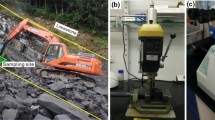Abstract
A number of techniques have been developed to detect and study fractures growth in rocks in the past few decades. Among them, the high-resolution X-ray computed tomography (CT) is a useful, rapid and nondestructive way to test and visualize the interiors of rocks in two and three dimensions. The difference in X-ray absorption between the mineral grains and the fractures can create well-contrasted CT images. In this paper, the main objective is to image the fractures in carbonated rock under uniaxial compression and rock fracturing experiments using the CT imaging technique in three dimensions. In the uniaxial compression test, the CT technology is performed to observe the macroscopic fractures in rock after failure. The 3D tomograms indicate that microcracks in rock mutually interconnect and eventually form macroscopic fractures. Then, the rock fracturing experiment is conducted to observe the geometry of induced fractures with the aid of the CT imaging. The 3D tomograms and visualized images show that the induced fracture intersects with the surface of rock sample, indicating that the CT technology can depict the induced fracture accurately. Moreover, the 3D visualized images illustrate that the macroscopic induced fracture in rock is produced with well-developed roughness. The experimental results show that the CT technique is a useful way to observe the fractures in rocks.








Similar content being viewed by others
References
Bohloli B, de Pater CJ (2006) Experimental study on hydraulic fracturing of soft rocks: influence of fluid rheology and confining stress. J Petrol Sci Eng 53:1–12
Carlson WD, Denison R, Ketcham RA (1999) High-resolution computed tomography as a tool for visualization and quantitative analysis of igneous textures in three dimensions. Electron Geosci 4:3
de Pater CJ, Dong Y (2007) Experimental study of hydraulic fracturing in sand as a function of stress and fluid rheology. Paper SPE 105620 presented at the SPE Hydraulic Fracturing Technology Conference, College Station, Texas, 29–31 January
Desrues J, Chambon R, Mokni M et al (1996) Void ratio evolution inside shear bands in triaxial sand specimens studied by computed tomography. Geotechnique 46:529–546
Dong Y, de Pater CJ (2008) Observation and modeling of the hydraulic fracture tip in sand. Paper ARMA 08-377 presented at the 42nd US Rock Mechanics Symposium and 2nd U.S.-Canada Rock Mechanics Symposium, San Francisco, 29 June–2 July
Fredrich JT, Di Giovanni AA, Nobel DR (2006) Prediction macroscopic transport properties using microscopic image data. J Geophys Res 111:B03201. doi:10.1029/2005JB003774
Jianxi R, Xiurun G (2001) Study of rock meso-damage evolution law and its constitutive model under uniaxial compression loading. Chin J Rock Mech Eng 20(4):425–431 (in Chinese)
Koeberl C, Denison C, Ketcham RA et al (2002) High-resolution X-ray computed tomography of impactites. J Geophys Res 107(E10):5089. doi:10.1029/2001JE001833
Lenoir N, Borner M, Desrues J et al (2007) Volumetric digital image correlation applied to X-ray microtomography images from triaxial compression tests on Argillaceous rock. Strain 43:193–205
Li S, Li T, Wang G et al (2007) CT real-time scanning tests on rock specimens with artificial initial crack under uniaxial conditions. Chin J Rock Mech Eng 26(3):484–492 (in Chinese)
Okumura S, Nakamura M, Tsuchiyama A (2006) Shear-induced bubble coalescence in rhyolitic melts with low vesicularity. Geophys Res Lett 33:L20316. doi:10.1029/2006GL027347
Rao KS, Noferesti H (2008) Brittle failure in heterogeneous crystalline rocks. Def Sci J 58(2):285–294
Renard F, Bernard D, Thibault X et al (2004) Synchrotron 3D microtomography of halite aggregates during experimental pressure solution creep and evolution of the permeability. Geophys Res Lett 31:L07607. doi:10.1029/2004GL019605
Renard F, Bernard D, Desrues J et al (2006) Characterisation of hydraulic fractures in limestones using X-ray microtomography. Advances in X-ray tomography for geomaterials. ISFE, London, pp 221–227 (ISBN: 1 905209 60 6)
Renard F, Bernard D, Desrues J et al (2009) 3D imaging of fracture propagation using synchrotron X-ray microtomography. Earth Planet Sci Lett 286:285–291
Weihua D, Yanqing W, Yibin P et al (2003) X-ray CT approach on rock interior crack evolution under low strain rate. Chin J Rock Mech Eng 22(11):1793–1797 (in Chinese)
Xiurun G, Jianxi R, Yibin P et al (1999) A real-in-time CT triaxial testing study on meso-damage evolution law of coal. Chin J Rock Mech Eng 18(5):497–502 (in Chinese)
Yanqing W, Weihua D (2002) X-ray CT observation on three-dimensional fracturing process of sandstone specimen under uniaxial condition. J Eng Geol 10(1):93–97 (in Chinese)
Yanqing W, Guangzhu C, Dianwu W (2005) Analysis of microcrack propagation process based on X-ray CT method. Chin J Appl Mech 22(3):484–490 (in Chinese)
Zhou H, Yang Y, Zhang Y et al (2010) Fine test on progressive fracturing process of multi-crack rock samples under uniaxial compression [J]. Chin J Rock Mech Eng 29(3):465–470 (in Chinese)
Acknowledgments
The authors are grateful for the Project Support by National Natural Science Foundation of China (No. 51204195).
Author information
Authors and Affiliations
Corresponding author
Rights and permissions
About this article
Cite this article
Jia, L., Chen, M. & Jin, Y. 3D imaging of fractures in carbonate rocks using X-ray computed tomography technology. Carbonates Evaporites 29, 147–153 (2014). https://doi.org/10.1007/s13146-013-0179-9
Accepted:
Published:
Issue Date:
DOI: https://doi.org/10.1007/s13146-013-0179-9




